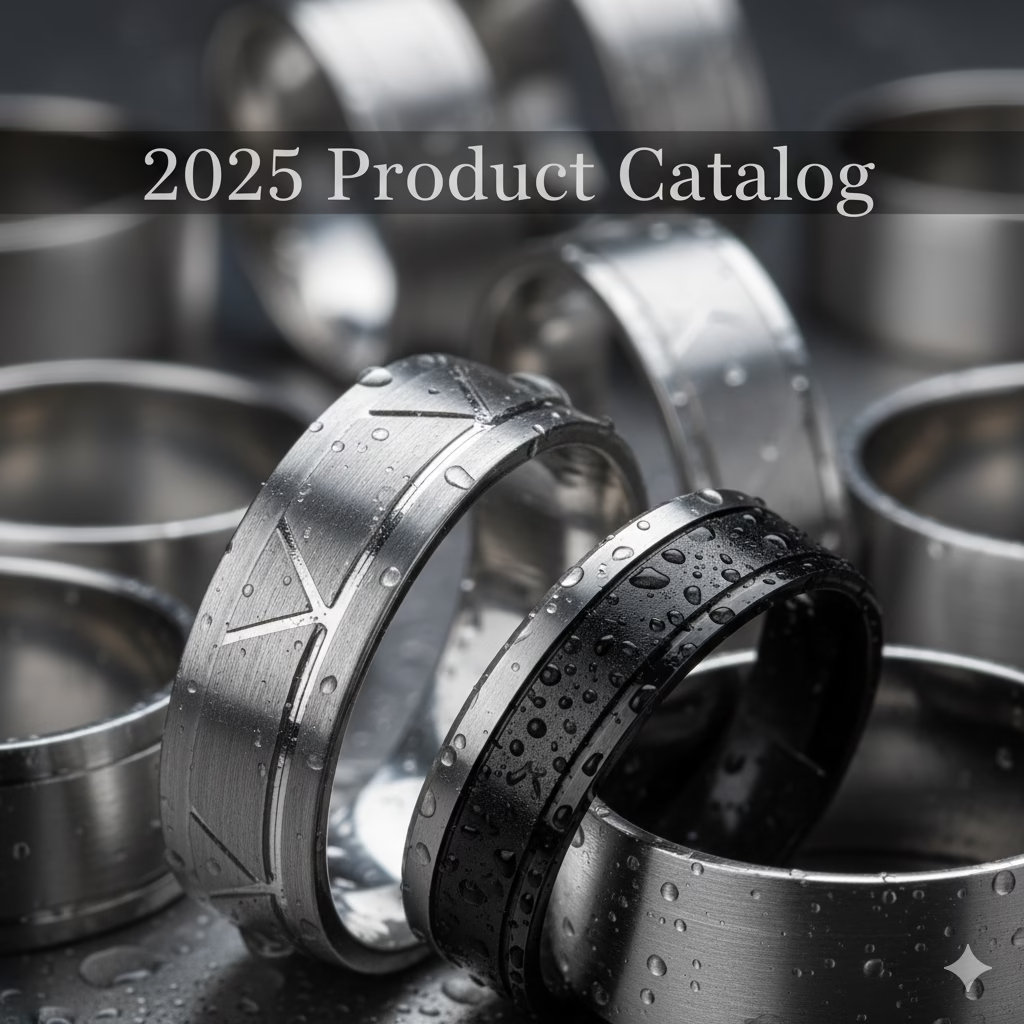Material Overview Stainless Steel and Titanium
When choosing between stainless steel and titanium rings, it’s helpful to understand the basics of each material. Both metals are popular in jewelry for their strength and durability, but they have distinct chemical and physical properties that affect their performance and appearance.
Stainless Steel Properties
- An alloy primarily made of iron, carbon, and chromium, which gives it excellent corrosion and rust resistance.
- Known for its hardness and strong resistance to scratches.
- Has a density of about 8 grams per cubic centimeter, making it heavier than titanium.
- Commonly used in medical instruments, automotive parts, kitchen appliances, and industrial tools due to its strength and resistance to wear.
Titanium Properties
- A lightweight metal known for its exceptional strength-to-weight ratio.
- Highly resistant to corrosion, including from saltwater and chemicals.
- Density is roughly 4.5 grams per cubic centimeter, making titanium rings noticeably lighter.
- Widely used in aerospace, medical implants, and high-performance sports equipment for its durability and light weight.
Common Uses Beyond Jewelry
- Stainless steel’s toughness and resistance to heat make it ideal for cookware, surgical tools, and construction materials.
- Titanium is favored in applications where strength and lightness are critical, such as aircraft frames, bicycle components, and medical prosthetics.
Visual and Tactile Differences in Jewelry
- Stainless steel rings tend to have a shinier, more polished look with a cool, metallic feel. They can feel heavier on the finger due to their density.
- Titanium rings often have a matte or brushed finish, which can appear more subtle and modern. Their light weight makes them comfortable for all-day wear.
- Both materials resist tarnishing and maintain their appearance well but offer distinct textures and visual weight.
Understanding these fundamental differences helps clarify why each metal appeals to different preferences when selecting a ring.
Durability Comparison

When comparing stainless steel vs titanium rings, durability is a big factor to consider. Here’s how they stack up:
| Feature | Stainless Steel | Titanium |
|---|
| Scratch Resistance | Moderate, Mohs scale ~5.5–6 | Higher, Mohs scale 6+ |
| Corrosion & Rust Resistance | Excellent, resists rust well | Outstanding, highly corrosion-resistant |
| Resistance to Bending/Breaking | Strong but heavier, can bend with force | Very strong and lightweight, resists bending and breaking |
| Hypoallergenic Properties | Usually hypoallergenic but may cause irritation for sensitive skin (depends on alloy) | Highly hypoallergenic, ideal for sensitive skin |
| Maintenance & Longevity | Requires occasional polishing to prevent dullness | Low maintenance, retains finish longer |
Scratch Resistance: Titanium generally handles scratches better than stainless steel, so it stays looking newer for longer. Stainless steel is tough but can show scratches with heavy use.
Corrosion Resistance: Both metals fight off rust and corrosion well, perfect for everyday wear, even in humid conditions or if exposed to water often.
Bending and Breaking: Titanium is lighter but also more flexible, which means it can take impacts without warping or cracking. Stainless steel is harder but heavier, and extreme force can bend it.
Hypoallergenic: Titanium rings are usually safer for those with sensitive skin or allergies. Stainless steel can sometimes cause irritation depending on the nickel content in the alloy.
Maintenance: Stainless steel might need polishing over time to keep its shine. Titanium rings require less upkeep and maintain their look with minimal care.
Weight and Comfort

When comparing stainless steel vs titanium rings, weight is one of the biggest differences you’ll notice. Titanium is much lighter, weighing about 4.5 grams per cubic centimeter, while stainless steel is heavier at roughly 8 grams per cubic centimeter. This makes titanium rings feel nearly half as heavy as stainless steel ones.
The lighter weight of titanium rings translates to more comfort for everyday wear. If you’re someone who wears rings from morning till night or needs something that won’t feel bulky during sports or physical activity, titanium is a great choice. Stainless steel rings, being denser, have a solid, substantial feel that some people prefer, but they might feel heavier if you’re not used to wearing rings.
Density directly affects how a ring feels on your finger. Titanium’s low density means it sits lighter and less restrictive, while stainless steel offers a heavier, more traditional ring feel. That weight can sometimes add to the sense of durability or luxury, but it might also cause fatigue over extended wear.
Ideal Use Cases Based on Weight Preferences
- Titanium Rings
- Best for sports, active lifestyles, or anyone seeking a lightweight, comfortable ring.
- Great if you’re not used to wearing rings regularly.
- Ideal for hot climates as lighter rings feel less intrusive.
- Stainless Steel Rings
- Suitable if you want a heavier, more traditional metal feel.
- Works well for casual wear or occasional use.
- Preferred by those who associate weight with durability.
Understanding how each metal’s weight impacts comfort can help you decide which ring will suit your daily needs best.
Price Range and Value for Money
When comparing stainless steel vs titanium rings, price is a big factor for most buyers. Stainless steel rings typically range from $20 to $100, making them a popular choice for affordable, durable jewelry. Titanium rings, on the other hand, usually cost between $100 and $300 due to their lightweight nature and higher material costs.
Several things affect these prices:
- Craftsmanship: Custom or intricate designs bump up the cost.
- Brand: Well-known brands often charge more.
- Purity and quality: Higher grade metals mean higher prices.
- Finishes and inlays: Specialized coatings or materials add to the cost.
Is the price difference justified? Titanium’s lighter weight, superior corrosion resistance, and hypoallergenic properties often make it worth the extra investment, especially if comfort and long-term wear are priorities. Stainless steel offers great value up front but may require more maintenance over time.
In terms of long-term ownership, titanium usually holds up better without needing replacement or repair, which can save money down the line. Stainless steel is cost-effective initially but might show wear faster, potentially leading to earlier replacement.
Style Design and Customization Options
When it comes to style, stainless steel and titanium rings each bring something unique to the table. Here’s how they stack up for popular designs and customization.
Stainless Steel Ring Trends
- Sleek, modern bands with polished or brushed finishes
- Bold, industrial looks often featuring black or gunmetal coatings
- Popular for inlays of wood, carbon fiber, or ceramic
- Engraving options widely available—simple text to intricate patterns
Titanium Ring Trends
- Lightweight, minimalist designs favored for everyday wear
- Matte and satin finishes dominate for a subtle, elegant look
- Color anodizing lets you choose from blues, blacks, and greens
- Smooth or beveled edges for increased comfort and style
Finishes, Colors, and Inlays Comparison
| Feature | Stainless Steel | Titanium |
|---|
| Finishes | Polished, brushed, matte, black coating | Matte, satin, anodized colors |
| Colors | Silver, black, gunmetal | Natural gray, blue, black, green |
| Inlay Options | Wood, carbon fiber, ceramic, mother-of-pearl | Carbon fiber, wood, ceramic |
| Engraving | Widely available, intricate designs | Also popular, deep and detailed |
Which Material Offers Better Customization
- Stainless steel is easier to polish and coat, making it a top choice for bold, eye-catching designs.
- Titanium stands out for color anodizing and comfort-focused finishes—great if you want something lightweight yet stylish.
Both materials offer solid engraving and inlay options, but stainless steel often allows for more variety due to its ability to support heavier coatings and sharper finishes. Titanium’s strength lets you customize without worrying about dents or scratches easily.
Choosing the Right Ring Factors to Consider
Picking between stainless steel and titanium rings comes down to your lifestyle and what matters most to you.
Personal lifestyle and activity
If you’re active or work with your hands, titanium’s strength and lightweight feel might be better. Stainless steel is durable too but heavier, which some find less comfortable for daily wear.
Budget constraints
Stainless steel rings are generally more affordable, making them a solid choice if you want style on a budget. Titanium rings cost more upfront but offer excellent long-term value thanks to their durability and comfort.
Skin sensitivities and allergies
Both metals are hypoallergenic, but titanium is less likely to cause any irritation, which is great if you have sensitive skin or allergies.
Weight and comfort preferences
Titanium’s low density means a ring that feels light and comfortable even when worn all day. Stainless steel rings feel heavier, which some people prefer for the solid, substantial feel on their finger.
Style and aesthetics
Consider the look you want. Stainless steel rings often come with a polished, shiny finish and classic styles. Titanium offers more options for modern designs, colors, and unique inlays.
Why Choose SteelRingFactory
When picking between stainless steel vs titanium rings, SteelRingFactory stands out for quality and trust. Here’s why:
Quality Assurance and Manufacturing
- Each ring goes through strict quality checks to ensure durability and finish
- Advanced manufacturing techniques deliver consistent, scratch-resistant surfaces
- Focus on producing rings built to last, perfect for daily wear in the US lifestyle
Ethical Material Sourcing
- Materials are responsibly sourced to meet environmental and labor standards
- Transparency in supply chain ensures you get genuine stainless steel or titanium
- Commitment to sustainable practices reflects modern customer values
Customization and Support
- Wide range of options: finishes, colors, inlays, and engravings available
- Personalized designs to match your style and needs
- Responsive customer service ready to help with sizing, designs, or aftercare
Customer Satisfaction
- Positive reviews highlight comfort, durability, and great value
- Many repeat buyers trust SteelRingFactory for wedding bands and casual rings
- Real feedback confirms rings hold up well over time with minimal maintenance
| Feature | SteelRingFactory Advantage |
|---|
| Quality Control | Rigorous checks for durability and finish |
| Material Transparency | Ethically sourced stainless steel and titanium |
| Customization | Engraving, inlays, and various finishes |
| Customer Support | Helpful and responsive team |
| Customer Reviews | Proven satisfaction and repeat customers |
Choosing SteelRingFactory means getting a ring that balances durability, comfort, and style — backed by solid support and ethical practices for US buyers.














